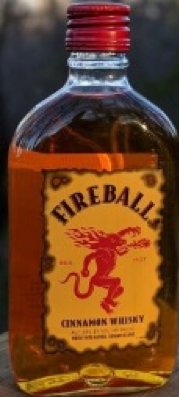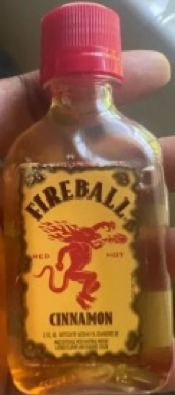Background
On January 7, 2023, a class action lawsuit was filed by Anna Marquez against Sazerac Company, Inc., the maker of Fireball® whisky, in the United States District Court for the Northern District of Illinois[1]. This case is primarily concerned with a claim of fraud under consumer protection laws, but that revelation was slow to emerge for me when I first heard about the lawsuit. While initially reading a news article summarizing this case, my eyes were immediately drawn to the images of the two products being offered and I found myself simultaneously perplexed and curious.


The above images were obtained from the complaint for Marquez v. Sazerac Company
Likelihood of Confusion?
As a trademark attorney, I routinely have conversations with my clients regarding their brands and applications for trademark registration that I help them file and prosecute to secure trademark protection. Almost every day, I find myself providing guidance on a frequent issue in trademark law called a “likelihood of confusion.” In short, when an application is filed for trademark registration with the United States Patent & Trademark Office (USPTO), a trademark examiner eventually reviews that application and compares it against a checklist of requirements. One of those requirements is that the applied-for trademark must not be “confusingly similar” to any other trademarks for which a registration already exists. A likelihood of confusion exists between two trademarks when the marks are so similar and the goods and/or services for which they are used are so related that consumers would mistakenly believe they come from the same source[2].
Looking at the images in the news article, I could not initially decipher what was different between the two bottles of alcohol portrayed. In my defense, I was looking at the images on my phone, so the text was small. However, everything about the labels on these two bottles looked identical and the only difference seemed to be the emphasis on “Cinnamon” in the label on the right vs. the one on the left. The headline of the article simply indicated a lawsuit had been filed concerning these two bottles, but the details were vague about the substance of the lawsuit.
I was perplexed because my trademark-attorney-mind immediately jumped to thinking, “well of course, whoever made one of these bottles of Fireball® must be infringing the trademark. There is clearly a strong case of a likelihood of confusion happening here. Those labels are indistinguishable to the typical consumer. So why is this controversial? Why is this even a story?”
Not a Likelihood of Confusion, But What?
I began to research the lawsuit more completely and came to find that Sazerac, the maker of Fireball® whisky, in fact, was the maker of both bottles of alcohol shown in the images. But one of the bottles did not actually contain whisky!
Well, the wheels in my head began turning because now I realized that this is a case of Fireball® whisky being confused with Fireball® malt beverage – Fireball® being confused with Fireball®. But what in the world was Fireball® malt beverage and which one had I imbibed over the years, the whisky or the malt beverage?
I was curious about this peculiar situation. Rather than the standard fact pattern that I most often deal with in my practice where there are two different companies selling the same or similar products with the same or similar trademarks; instead, we have the same company selling two different products with the same trademark!
Since the same company is selling both products, clearly it is not possible for there to be a trademark infringement case here because Sazerac cannot infringe its own trademark by using it on two different products. I’ll leave it to those more experienced with consumer fraud and class actions to opine on the merits of whether there is a valid cause of action for fraud or otherwise as alleged in the actual complaint filed. My interest is with trademark law.
Still an Example of Confusion, But Different
Despite this case not fitting into the framework of a conventional trademark likelihood of confusion analysis, what it does provide is a great example of what customer confusion in the marketplace can look like viewed through the lens of trademark law.
Picture yourself, for a moment, walking into a store and seeing the bottle on the right (in the above images). Would you even give it a second thought as to whether it was Fireball® whisky? I think not! I would be (and in fact was) handily fooled into thinking the bottle on the right contained whisky with a cinnamon kick – familiar to those of us having experience with that particular libation. But as the complainant in the lawsuit, Ms. Marquez proclaimed, “[t]he bottles appear identical but for the word ‘Whisky’ on the front label, which most purchasers seeking alcohol will not even detect.” If the bottle on the right were in reality manufactured by someone other than Sazerac (and without Sazerac’s permission via a license) then this would indeed be a clear-cut, open-and-shut, case of trademark infringement due to the likelihood of confusion, i.e., the likelihood that consumers would be confused into thinking that the product associated with the label on the left is the same as the product associated with the label on the right. But that is not what the facts provide.
In truth, what we have here is a brand/trademark that is so well-known, so strong, possibly even famous, that consumers who are exposed to the familiar logo of a mythical griffon breathing fire on top of that golden parchment background with the fire-red top for even a fraction of a second may even experience that cinnamon-whisky flavor manifesting in their minds. That cinnamon-whisky flavor, I presume based on the observations of Ms. Marquez, is a far cry from the cinnamon-malt flavor found in the alternative embodiment. They are different base alcohols. Imagine the shock to one’s system when breaking open the fire-red seal on the top of the bottle, pouring its contents over a few ice cubes freshly arranged in a fine crystal glass (with or without additional drink components), and taking that first sip of whisky…no, malt-beverage… and confusion sets in. What is this? What is that taste?
Brand Expansion
It appears that Sazerac is attempting to broaden its product offerings under this well-known Fireball® brand. Upon even further investigation, I uncovered trademark applications and registrations for the mark FIREBALL by Sazerac for not only whisky and malt liquor, but also nuts, trail mix, holiday nog, dried fruit, ice cream, barbecue sauce, and cigars, as well as many non-consumable items (keychains, towels, phone cases, etc.). So, it seems for those seeking a fully immersive cinnamon experience, you need not look any further than Sazerac and Fireball®!
Brand expansion can sometimes be a bumpy road. Consumers that are very familiar with, even loyal to, a product made by a particular source company like Sazerac can get used to seeing that familiar trademark logo like Fireball® and the corresponding product in the store or on the shelf at home. When they pick it up to use or consume it (depending on the product) they have certain expectations as to what will occur. Seeing new and different products with the same well-known trademark can generate instances of confusion. One way of handling this can be to prominently add the word “Brand” after the trademark and before an also-prominent generic description of the different products. This approach was briefly referred to in the lawsuit as one that Sazerac has not implemented on the malt-beverage version of the Fireball® product. More helpful would be a marketing campaign espousing the attributes of these amazing new products being launched in association with the original brand/trademark. All these strategies, and more, can be part of a good trademark strategy and a preferred way to roll out expansion products to create an umbrella brand.
However, based only on the narrative provided in the lawsuit, it appears whatever strategies Sazerac has thus far implemented in their brand expansion, Ms. Marquez did not feel sufficiently appraised of this alternative alcoholic beverage concoction. It is worthy of confusion in my view, and I for one have at least two takeaways. One is that customer confusion can occur when a trademark owner attempts to expand a product offering beyond a single product that enjoys consumer recognition and loyalty, so careful consideration must be given to updating the marketplace of such alternative product offerings. The second is that whenever I am in the market for a Fireball® whisky, not a malt beverage, I’m going to pay closer attention than I may have been inclined to pay before.
If you are interested in learning more about trademarks, please contact Sean Detweiler.
[1] Marquez v. Sazerac Company, Inc. – 1:23-cv-00097
[2] https://www.uspto.gov/trademarks/search/likelihood-confusion



